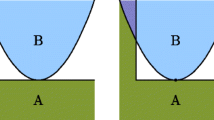Abstract
Using the topological degree and the concept of exceptional family of elements for a continuous function, we prove a very general existence theorem for the nonlinear complementarity problem. This result is an alternative theorem. A generalization of Karamardian's condition and the asymptotic monotonicity are also introduced. Several applications of the main results are presented.
Similar content being viewed by others
References
Altman, M. (1957), A fixed point theorem in Hilbert space, Bull. Acad. Polon. Sci. 5: 19–22.
Carbone, A. and Isac, G. (1998), The generalized order complementarity problem. Applications to economics and an existence result, Nonlinear Studies 5(2): 139–152.
Cottle, R.W., Pang, J.S. and Stone, R.E. (1992), The Linear Complementarity Problem, Academic Press, New York.
Cottle, R.W. and Dantzig, G.B. (1970), A generalization of the linear complementarity problem, J. Combinatorial Theory 8: 79–90.
Ebiefung, A.A. (1995), Nonlinear mappings associated with the generalized linear complementarity problem, Math. Programming 69: 255–268.
Ebiefung, A.A. and Kostreva, M.M. (1993), The generalized Leontief input-output model and its application to the choice of new technology, Annals Oper. Res. 44: 161–172.
Fisher, M.L. and Tolle, J.W. (1977), The nonlinear complementarity problem: Existence and determination of solution, SIAM J. Control Opt. 15(4): 612–624.
Isac, G. (1988), Fixed point theorem coincidence equations on convex cones and complementarity problem, Contemporary Mathematics 72: 139–155.
Isac, G. (1992), Complementarity Problem, Lecture Notes in Mathematics 1528, Springer Verlag, Berlin/New York.
Isac, G. (1995), On an Altman type fixed point theorem on convex cones, Rocky Mountain J. Math. 25(2): 701–714.
Isac, G., Bulavski, V. and Kalashnikov, V. (1997), Exceptional families, topological degree and complementarity problems, J. Global Opt. 10: 207–225.
Isac, G. and Obuchowska, W.T. (1998), Functions without exceptional families of elements and complementarity problem, J. Opt. Theory Appl. 99(1): 147–163.
Kalashnikov, V.V. (1995), Complementarity Problem and the Generalized Oligopoly Model, Habilitation Thesis, CEMI, Moscow (in Russian).
Karamardian, S. (1971), Generalized complementarity problem, J. Optim. Theory Appl. 8(3): 161–168.
Lloyd, N.G. (1978), Degree Theory, Cambridge University Press.
Moreau, J. (1962), Décomposition orthogonal d'une espace hilbertien selon deux cônes mutuellement polaire, C. R. Acad. Sci. Paris Tom A, 225: 238–240.
Mohan, S.R., Neogy, S.K. and Sridhar, R. (1996), The generalized linear complementarity problem revisited, Math. Programming 74: 197–218.
Moré, J.J. (1974), Coercivity conditions in nonlinear complementarity problems, SIAM Review 16(1): 1–16.
Moré, J.J. (1976), Classes of functions and feasibility conditions in nonlinear complementarity problems, Math. Programming 6: 327–338.
Moré, J.J. and Rheinboldt, W. (1973), On P and S-function and related classes of N-dimensional nonlinear mappings, Linear Algebra and its Applications, 6: 45–68.
Smith, T.E. (1984), A solution condition for complementarity problems with application to spatial price equilibrium, Applied Mathematics and Computation 15: 61–69.
Szanc, B.P. (1989), The Generalized Complementarity Problem, Ph. D. Thesis, Rensselaer Polytechnic Institute, Troy, New York.
Sznajder, R. and Gowda, M.S. (1995), Generalization of P0-and P-properties; Extended vertical and horizontal linear complementarity problems, Linear Alg. Appl. 223/224: 695–715.
Vandeberge, L., De Moor, B.L. and Vandervalle, J. (1989), The generalized linear complementarity problem applied to the complete analysis of resistive piecewise-linear circuits, IEEE Trans. Circuits and Syst. 11: 1382–1391.
Zhao, Y.B. (1997), Exceptional families and finite-dimensional variational inequalities over polyhedral convex sets, Appl. Math. Computation 87: 111–126.
Zhao, Y.B., Han, J.Y. and Qi, H.D. (1997), Exceptional families and existence theorems for variational inequality problems (Preprint, Institute of Appl. Math. Academia SINICA, Beijing).
Zhao, Y.B., Han, J.Y. (1997), Exceptional family for variational inequality problem and its applications (Preprint, Institute of Appl. Math. Academia SINICA, Beijing).
Author information
Authors and Affiliations
Rights and permissions
About this article
Cite this article
Isac, G., Carbone, A. Exceptional Families of Elements for Continuous Functions: Some Applications to Complementarity Theory. Journal of Global Optimization 15, 181–196 (1999). https://doi.org/10.1023/A:1008376709933
Issue Date:
DOI: https://doi.org/10.1023/A:1008376709933



